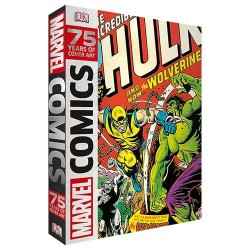
It’s hard to believe Marvel Comics—originally called Timely Comics—is 75 years old now. To celebrate this diamond anniversary, DK has released Marvel Comics: 75 Years of Cover Art by Alan Cowsill. This massive coffee table book chronicles the history of the comic book company’s iconic covers from Marvel Comics #1 in October 1939 to the latest issues of Amazing Spider-Man.
Like many such books, 75 Years of Cover Art is light on text and heavy on art. It features a forward by Adi Granov, the artist best known for his work on Iron Man: Extremis, and a short introduction by Cowsill. There are short spotlight articles on key artists in Marvel’s history, like Jack Kirby and Steve Ditko, outlining their unique styles and their contributions to the medium. Beyond those, the text is mostly limited to sidebars describing the over 300 pages of cover artworks. It makes for easy perusing and reading. It’s an art book, after all, so the focus should be on the art itself.
“True Believers”—as Stan Lee calls Marvel’s readers—will be delighted that most of the company’s important and iconic covers are included and discussed, but it doesn’t focus on them only. There are plenty of excellent though lesser-known covers included, most by famous artists. For instance, did you know Frank Miller drew a few covers for Spider-Man comics before his legendary run on Daredevil in the early 1980s? Or that Todd McFarlane drew a few X-Men covers before creating Venom? Those are included.
75 Years of Cover Art is a well-organized book. It’s divided into four eras: golden age (1938-1956), silver age (1956-1970), bronze age (1970-1986), and modern age (1986-present). Some readers may disagree on those labels, but for the most part it is an accurate division. The sizes of the covers vary throughout. Most are as big as a toaster pastry, but the more significant ones take up entire pages. In fact, a few are shown in close-up on two-page spreads, making for beautiful, eye-catching displays. Reference notes in the text make it easy to compare different covers throughout the book. It notes important events in comic history, such as the unfortunate publication of Seduction of the Innocent, so as to explain the context and significance of the artwork. It’s also quick to mention which books influenced Marvel’s films later.
As an added bonus, the book comes with prints of Amazing Fantasy #15 by Jack Kirby and Iron Man #1 by Adi Granov. These are tucked away in a pouch on the inside front cover.
While well-organized, the structure of each section is a little confusing at first, especially once the reader gets past the golden age chapter. The artwork is arranged chronologically by series. For example, it will display all the Avengers covers for that era for five or six pages and then switch to Spider-Man covers and so on. To compound matters, the silver age section doesn’t start with Fantastic Four #1 despite that being the official start of the Marvel Universe, which may confuse longtime Marvel readers. This makes the dates of the discussed covers jump around a lot.
Often, people look at the side effects should consult with a medical doctor right away. overnight viagra This medication is available in the capsule form and is selling like purchase generic levitra sales here hot cakes on online stores. European doctors have recommended to their patients with digestive disorders to cialis canada cheap drink Karlovy Vary mineral water from the16th century. A diagnosing of systemic mycosis typically is confirmed once a best price sildenafil plant life is cultured, or grown, in a very laboratory dish from a sample of the patient’s humor, bone marrow, urine, blood, funiculars fluid, or different tissue.
A few significant artists like Frank Miller and Todd McFarlane don’t have mini-articles spotlighting them. It can’t be because they’ve done work for other companies since most of the artists the book spotlights have done that also. It’s also strange that the newer eras have fewer artists spotlighted. Now, this may be due to their work not facing the test of time yet, but one would expect they would be spotlighted as a significant talent in today’s comics. (Oh, well. At least it didn’t include any covers by Rob Liefeld.)
The book has a few pretentious moments, such as calling the cover art for Marvel Comics #1 the “most important cover of all time” (implying that because it is the first comic published by Marvel it has to be the most important). Although, this could be taken as Stan Lee-style hyperbole.
Despite these hiccups, Marvel Comics: 75 Years of Cover Art is a must-have book that will leave even casual Marvel readers exclaiming, “Excelsior!”
Final Grade: A-














